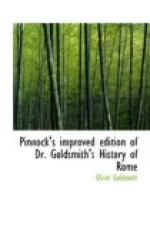23. Before concluding this chapter, we must notice the triumphal processions granted to victorious commanders. Of these there are two kinds; the lesser triumph, called an ovation,[2] and the greater, called, emphatically, the triumph. In the former, the victorious general entered the city on foot, wearing a crown of myrtle; in the latter, he was borne in a chariot, and wore a crown of laurel. The ovation was granted to such generals as had averted a threatened war, or gained some great advantage without inflicting great loss on the enemy. The triumph was allowed only to those who had gained some signal victory, which decided the fate of a protracted war. The following description, extracted from Plutarch, of the great triumph granted to Paulus AEmilius, for his glorious termination of the Macedonian war, will give the reader an adequate idea of the splendour displayed by the Romans on these festive occasions.
The people erected scaffolds in the forum and circus, and all other parts of the city where they could best behold the pomp. The spectators were clad in white garments; all the temples were open, and full of garlands and perfumes; and the ways cleared and cleansed by a great many officers, who drove away such as thronged the passage, or straggled up and down.
The triumph lasted three days; on the first, which was scarce long enough for the sight, were to be seen the statues, pictures, and images of an extraordinary size, which were taken from the enemy, drawn upon seven hundred and fifty chariots. On the second was carried, in a great many wains, the fairest and richest armour of the Macedonians, both of brass and steel, all newly furbished and glittering: which, although piled up with the greatest art and order, yet seemed to be tumbled on heaps carelessly and by chance; helmets were thrown on shields, coats of mail upon greaves; Cretan targets and Thracian bucklers, and quivers of arrows, lay huddled among the horses’ bits; and through these appeared the points of naked swords, intermixed with long spears. All these arms were tied together with such a just liberty, that they knocked against one another as they were drawn along, and made a harsh and terrible noise, so that the very spoils of the conquered could not be beheld without dread. After these wagons loaded with armour, there followed three thousand men, who carried the silver that was coined, in seven hundred and fifty vessels, each of which weighed three talents, and was carried by four men. Others brought silver bowls, and goblets, and cups, all disposed in such order as to make the best show, and all valuable, as well for their magnitude as the thickness of their engraved work. On the third day, early in the morning, first came the trumpeters, who did not sound as they were wont in a procession or solemn entry, but such a charge as the Romans use when they encourage their soldiers to fight. Next followed young men, girt about with girdles curiously wrought, who




